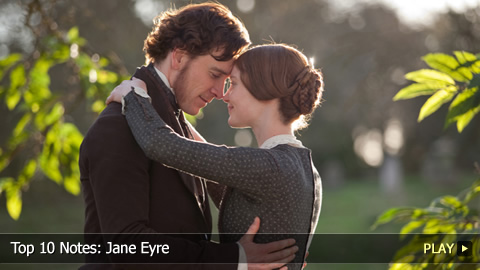Top 10 Notes: Jane Eyre

Special thanks to our users Daniel Fong, kristikkc and riderj123 for submitting the idea on our Suggest Page at WatchMojo.comsuggest
#10: About the Author
Born in 1816 in Thornton, England, Emily Brontë was one of six children, which included fellow novelists Emily and Anne Bronte. Following their mother’s death, Charlotte was mostly home-schooled and soon began publishing poems under a pen name. Despite several family deaths, she found success with writing novels but her health deteriorated too. She died in 1855.
#9: Influences and Inspirations
“Jane Eyre” is based on many of Brontë’s personal experiences though it’s still a work of fiction. For instance, the school she attended with her sisters inspired Lowood, while some family members inspired the story’s characters. While it’s mainly a coming of age novel, “Jane Eyre” also includes elements of gothic fiction, naturalism, melodrama and social criticism.
#8: Settings and Era
“Jane Eyre” is based on many of Brontë’s personal experiences though it’s still a work of fiction. For instance, the school she attended with her sisters inspired Lowood, while some family members inspired the story’s characters. While it’s mainly a coming of age novel, “Jane Eyre” also includes elements of gothic fiction, naturalism, melodrama and social criticism.
#8: Settings and Era
Though “Jane Eyre” is set during 19th century England, most of the places and buildings mentioned are made up. The different places where the title character and protagonist spends her time represent the different stages of her life: Gateshead, Lowood School, Thornfield Hall and so on.
#7: Plot
Narrated in the first person, the novel follows Jane Eyre through her childhood to adulthood. After being taken in by her uncle’s family following her parents’ deaths, she suffers much abuse by her aunt and cousins. At Lowood, she is publicly shamed by a school official but finds support from a friend and a teacher. While being the governess of Thornfield Hall, Jane falls in love with the master of the house, Edward Rochester. When she discovers he’s already married and has locked up his wife Bertha Mason, Jane leaves and strikes out on her own. Passing out from starvation one day, Jane is saved by the clergyman St. John Rivers. He and his sisters take her in and they discover they’re related through their late uncle. After considering St. John’s marriage proposal, Jane returns to Thornfield and finds Mrs. Rochester has killed herself. Despite Rochester’s disfiguration from a fire, Jane’s love for him endures and they are married.
#6: Jane Eyre
As the novel’s main character, we learn from Jane that she’s an orphan and had an abusive childhood. This has pushed her to retreat in her own world. Yet, Jane is also very passionate and doesn’t believe in unjust punishment - so she’ll make her beliefs known if need be. She carries this into adulthood, as demonstrated by her refusal to stay with Rochester when she finds out he’s already married. As a governess, she is a teacher to others, but Jane also accepts guidance and mentoring from other females. When it comes to men, Jane is more likely to stand her ground, but she can be forgiving and romantic.
#5: Edward Fairfax Rochester
As the master of Thornfield Hall, Edward is an older and not particularly good-looking man. But he’s very passionate about what he wants, especially Jane. His critical and emotionally conflicting nature make him a Byronic hero. Though he can be quite violent, he justifies his actions, such as locking up his crazy wife, with the reasoning that right and wrong can be relative according to the situation.
#4: St. John Eyre Rivers
St. John is a clergyman who saves Jane’s life after she loses consciousness. While his hospitality shows his softer side, the extremely religious man is mostly driven by his ambition to become a missionary in India. He’s so devoted to this that he’s willing to give up his love for a woman named Miss Rosamond Oliver because he doesn’t think she’d make a good wife. Instead, he asks his cousin Jane to marry him despite his lack of feelings for her and ends up going without her at the end.
#3: Values and Themes
One of “Jane Eyre”’s most prominent themes is the characters’ different approaches to morality. However, society and class, religion, the relationship between men and woman as well as love and forgiveness are also important.
#2: Modern Popularity
Published in 1857 under Currer Bell, “Jane Eyre” wasn’t well-received initially because it seemed to reject Victorian principles. But thanks to its relatable characters and intense themes, it’s since become a staple in high school English literature.
#1: Adaptations
Though it’s been referenced and reworked in literature, the novel has also been adapted for the screen. The most famous film versions include 1944’s version with Orson Welles and the 1996 Hollywood movie.
Do you agree with our list? What’s your favorite piece of “Jane Eyre” trivia? With new top 10s published daily, be sure to subscribe to WatchMojo.com.